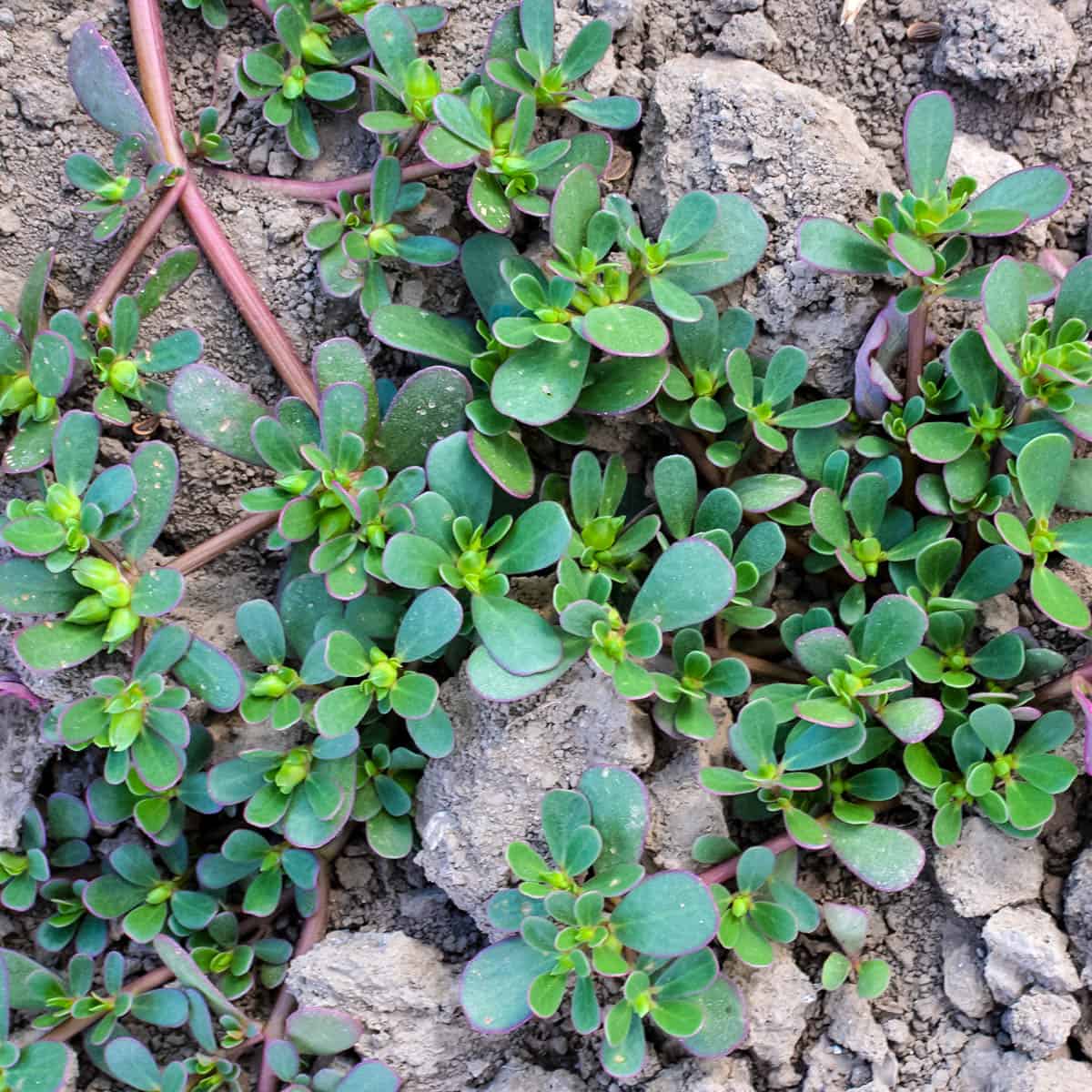Facts About Purslane (Portulaca oleracea) Plant

Purslane is a leafy green vegetable that can be consumed either raw or cooked. It is also known as Portulaca oleracea, and is sometimes referred to as pigweed, little hogweed, fatweed or pusley.
Purslane has a slightly sour or salty flavour that is akin to spinach and watercress. It is a succulent plant that primarily consists of water, with red stems and small green leaves.
Purslane can be used in various ways, such as in salads or sandwiches, similar to spinach or lettuce. It grows in different environments and can be found in many parts of the world.
Furthermore, it is rich in various essential nutrients, with a 100-gram (3.5 oz) serving containing vitamins A and C, magnesium, manganese, potassium, iron, calcium, and small amounts of vitamins B1, B2, B3, folate, copper, and phosphorus. Purslane is a nutritional powerhouse, indeed!
Chemical components of Purslane (Portulaca oleracea) Plant
- Polysaccharides: These are complex carbohydrates that can have various biological activities, such as immunomodulation, anti-tumour, anti-inflammatory, and antioxidant effects. Purslane polysaccharides have been extracted, purified, and characterized by different methods, and have shown potential applications in food, medicine, and cosmetics.
- Alkaloids: These are nitrogen-containing organic compounds that can have various pharmacological effects, such as analgesic, antispasmodic, anti-diabetic, and anti-microbial effects. Purslane alkaloids include portulacine, portulacol, and portulacine A, which have been isolated and identified by different techniques and have shown anti-inflammatory and anti-diabetic activities.
- Flavonoids: These are phenolic compounds that can have various antioxidant, anti-inflammatory, anti-cancer, and anti-diabetic effects. Purslane flavonoids include kaempferol, luteolin, apigenin, myricetin, and quercetin, which are the major components of purslane.
- Terpenoids: These are hydrocarbon compounds that can have various anti-inflammatory, anti-cancer, anti-microbial, and anti-fungal effects. Purslane terpenoids include portulene, portulacene, and portulene A, which have been isolated and identified by different methods and have shown anti-inflammatory and anti-cancer activities.
- Omega-3 fatty acids: These are polyunsaturated fatty acids that can have various benefits for heart health, brain function, and inflammation. Purslane has the highest levels of omega-3 fatty acids among land-based plants, especially alpha-linolenic acid (ALA), which is beneficial for heart health and brain function. It also has trace amounts of eicosapentaenoic acid (EPA), which is more bioavailable and anti-inflammatory than ALA.
- These are some of the main chemical components of purslane, but there may be others that have not been discovered or studied yet. Purslane is a plant that has many potential uses and benefits, and it is worth exploring more.
- Vitamins
Vitamin A (from beta-carotene): 26% of the DV.
Vitamin C: 35% of the DV.
Magnesium: 17% of the DV.
Manganese: 15% of the DV.
Potassium: 14% of the DV.
Iron: 11% of the DV.
Calcium: 7% of the RDI.
It also contains small amounts of vitamins B1, B2, B3, folate, copper and phosphorus
Medicinal uses of Purslane (Portulaca oleracea) Plant
- Improving digestion and immune system: Purslane contains vitamins A and C which are essential for maintaining healthy mucous membranes and fighting infections. Purslane also has anti-inflammatory properties that can help reduce intestinal inflammation and irritation.
- Lowering the cancer risk: Purslane is rich in antioxidants, such as beta-carotene, vitamin E, glutathione, and betalain, that can protect cells from oxidative damage and prevent DNA mutations. Purslane also has omega-3 fatty acids, which can modulate the expression of genes involved in cancer development and progression.
- Supporting heart health: Purslane has the highest levels of omega-3 fatty acids among land-based plants, which can help lower blood pressure, cholesterol, and triglyceride levels, and prevent blood clots and inflammation in the arteries. Purslane also has magnesium and potassium, which are important for regulating heart rhythm and blood flow.
- Strengthening bone health: Purslane has calcium and magnesium, essential for building and maintaining strong bones and teeth. Purslane also has vitamin K, which is involved in bone metabolism and blood clotting. Purslane can help prevent osteoporosis and fractures by enhancing bone density and quality
- Vitamins and other important properties of Purslane:
- Vitamin C: Also known as ascorbic acid, vitamin C is essential for maintaining healthy skin, muscles, and bones. It’s also a powerful antioxidant that helps protect cells from damage.
Vitamin E: Purslane contains high levels of alpha-tocopherol, a form of vitamin E that may help protect cell membranes from damage.
Vitamin A: Purslane is rich in beta-carotene, an antioxidant that the body converts into vitamin A. Vitamin A is important for maintaining healthy eyesight.
Glutathione: This antioxidant plays a crucial role in protecting cells from damage.
Melatonin: Purslane also contains melatonin, a hormone that can help regulate sleep cycles and improve sleep quality.
Betalain: Purslane synthesizes betalains, antioxidants that have been shown to protect LDL particles from damage, reducing the risk of heart disease.
- Vitamin C: Also known as ascorbic acid, vitamin C is essential for maintaining healthy skin, muscles, and bones. It’s also a powerful antioxidant that helps protect cells from damage.
Incorporating purslane into your diet can greatly boost your intake of these essential vitamins and antioxidants. One study in obese teenagers reported that purslane seeds reduced LDL (the “bad”) cholesterol and triglyceride levels, both of which are associated with an increased risk of heart disease. The researchers attributed these effects to the antioxidants and plant compounds in the seeds
How to Use the Purslane Plant
The purslane plant is a nutritious and versatile green that can be used in many ways. Here are some suggestions on how to use the Purslane plant
- Eat it raw or cooked: You can eat the leaves, stems, flowers, and seeds of the purslane plant, either raw or cooked. They have a crisp, refreshing, and slightly sour taste that can add flavour and texture to salads, sandwiches, soups, stir-fries, and more.
- Grow it as a microgreen: You can grow purslane as a microgreen, which is a young plant that is harvested when it has only a few leaves. Microgreens are rich in antioxidants, vitamins, and minerals, and can be used as a garnish or a salad ingredient. To grow purslane as a microgreen, you need to sow the seeds in a shallow container with moist soil and place it in a sunny spot. You can harvest the microgreens in about two weeks when they are about 2-3 inches tall.
- Grow it as a vegetable: You can also grow purslane as a vegetable, which is a mature plant that is harvested when it has many leaves and flowers. Purslane is a fast-growing and low-maintenance plant that can thrive in various conditions. You can sow the seeds directly in the ground, in a sunny and well-drained spot, from late spring to late summer. You can harvest the leaves and stems as needed, and the flowers and seeds when they appear.
- Use it as a medicinal plant: You can use purslane as a medicinal plant, as it has many health benefits. Purslane is a good source of omega-3 fatty acids, which can support heart health and brain function. It also contains vitamins A, C, E, and K, as well as minerals such as magnesium, calcium, iron, and potassium, which are essential for various bodily functions. Purslane also has anti-inflammatory, antioxidant, anti-cancer, and anti-diabetic properties, and can help improve digestion, immunity, bone health, and skin health.
Some of the side effects of purslane are:
- Kidney stones: Purslane contains oxalates, which are compounds that can bind with calcium and form kidney stones. People who have a history of kidney stones or high levels of oxalates in their urine should avoid eating purslane or limit their intake
- Allergic reactions: Some people may be allergic to purslane or its components, such as alkaloids, flavonoids, or terpenoids. Symptoms of an allergic reaction may include skin rashes, itching, swelling, breathing difficulties, or anaphylaxis. If you experience any of these symptoms after eating purslane, seek medical attention immediately.
- Drug interactions: Purslane may interact with some medications, such as blood thinners, diuretics, or anti-diabetic drugs. Purslane has anti-coagulant and anti-platelet properties, which can increase the risk of bleeding or bruising. Purslane also has diuretic and anti-diabetic effects, which can lower blood pressure and blood sugar levels. If you are taking any of these medications, consult your doctor before eating purslane
These are some of the possible side effects of purslane, but they may not occur in everyone. Purslane is generally safe and nutritious when consumed in moderation and as part of a balanced diet. However, if you have any medical conditions or concerns, it is best to consult your doctor before eating purslane.
The Video Below Illustrates some benefits and uses of the Purslane Plant
Reference
- https://www.drugs.com/npp/purslane
- https://draxe.com/nutrition/purslane

